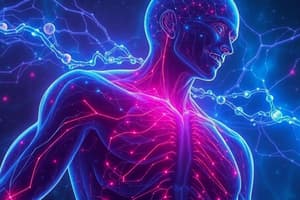Podcast
Questions and Answers
What is the class of pyridostigmine bromide?
What is the class of pyridostigmine bromide?
- Beta-blocker
- Antidepressant
- Calcium channel blocker
- AchE inhibitor (correct)
What is the mechanism of action (MOA) of pyridostigmine bromide?
What is the mechanism of action (MOA) of pyridostigmine bromide?
Inhibits the breakdown of acetylcholine in the brainstem, increases acetylcholine.
What condition is pyridostigmine bromide indicated for?
What condition is pyridostigmine bromide indicated for?
Myasthenia gravis
What are the contraindications for pyridostigmine bromide?
What are the contraindications for pyridostigmine bromide?
What precautions should be considered when administering pyridostigmine bromide?
What precautions should be considered when administering pyridostigmine bromide?
How should pyridostigmine bromide be administered?
How should pyridostigmine bromide be administered?
What are some of the side effects (s/s) of pyridostigmine bromide?
What are some of the side effects (s/s) of pyridostigmine bromide?
What nursing implications should be considered when giving pyridostigmine bromide?
What nursing implications should be considered when giving pyridostigmine bromide?
What is the antidote for cholinergic crisis?
What is the antidote for cholinergic crisis?
Flashcards are hidden until you start studying
Study Notes
Pyridostigmine Bromide Overview
- Class: Acetylcholinesterase (AchE) inhibitor
- Mechanism of Action (MOA): Inhibits breakdown of acetylcholine (Ach), increasing Ach levels in the brainstem
- Indication (IND): Primarily used for treating Myasthenia gravis
Contraindications and Cautions
- Contraindications: Gastrointestinal (GI) or genitourinary (GU) obstruction
- Cautions: Use with care in patients with asthma, peptic ulcers, renal dysfunction, cardiac dysrhythmia, and seizure disorders
Pharmacokinetics and Administration
- Pharmacology: Food intake decreases absorption; administer on an empty stomach
- Administration route: Oral (PO)
Side Effects and Symptoms
- Common side effects:
- Seizures
- Nausea and vomiting (N/V)
- Diarrhea
- Respiratory depression
- Bronchospasm
- Cardiac dysrhythmias
- Bradycardia
- Orthostatic hypotension
- Miosis (constricted pupils)
- Blurry vision
- Dyskinesia
- Diaphoresis (excessive sweating)
- Increased salivation
Nursing Implications
- Ensure medication is administered punctually
- Administer on an empty stomach to maximize absorption
- Assess for swallowing difficulties (dysphagia)
- Monitor vital signs (VS)
- Implement safety precautions to prevent falls
- Seizure precautions are essential
- Avoid co-administration with other anticholinergic drugs
Antidote for Cholinergic Crisis
- Antidote: Atropine sulfate used to counteract overdoses or severe side effects of cholinergic agents
Studying That Suits You
Use AI to generate personalized quizzes and flashcards to suit your learning preferences.



